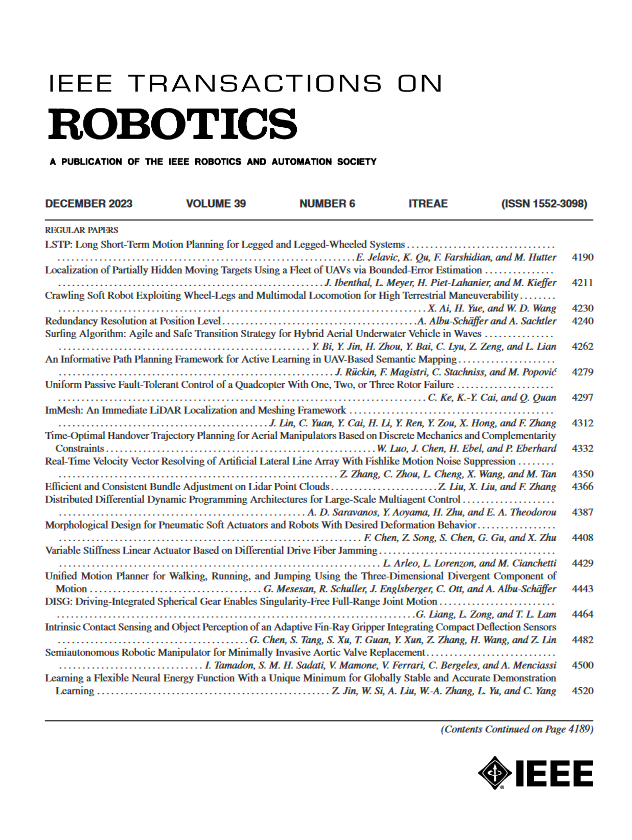面向车辆定位的图像与LiDAR点云端到端2D-3D配准
IF 10.5
1区 计算机科学
Q1 ROBOTICS
引用次数: 0
摘要
使用内置地图的机器人定位对于包括精确导航和移动操作在内的各种任务至关重要。一种流行的机器人定位方法是基于图像到点云配准,它结合了基于光照不变的激光雷达映射和经济的基于图像的定位。然而,最近的图像到点云配准工作要么将配准分为单独的模块,要么将点云投影到深度图像上进行RGB和深度图像的配准。在本文中,我们提出了一种新的端到端2D-3D配准网络I2PNet,它使用统一目标的差分模块将原始3d点云直接配准到2d RGB图像。提出了基于2D-3D差分关联的2D-3D成本体积模块,在特征提取和姿态回归之间架起桥梁。在2D-3D代价体模块中,在与本然无关的归一化平面上隐式构造软点像素对应关系。此外,我们引入了一个离群值掩模预测模块,在姿态回归之前对2D-3D关联中的离群值进行过滤。此外,我们提出了粗到精的2D-3D配准架构,以提高定位精度。在KITTI、nuScenes、M2DGR、Argoverse、Waymo和Lyft5数据集上进行了广泛的定位实验。结果表明,I2PNet在很大程度上优于目前的最先进技术,并且具有比以前的工作更高的效率。此外,我们将I2PNet的应用扩展到相机-激光雷达在线校准,并证明I2PNet在在线校准任务上优于最近的方法。本文章由计算机程序翻译,如有差异,请以英文原文为准。
End-to-End 2D-3D Registration Between Image and LiDAR Point Cloud for Vehicle Localization
Robot localization using a built map is essential for a variety of tasks including accurate navigation and mobile manipulation. A popular approach to robot localization is based on image-to-point cloud registration, which combines illumination-invariant LiDAR-based mapping with economical image-based localization. However, the recent works for image-to-point cloud registration either divide the registration into separate modules or project the point cloud to the depth image to register the RGB and depth images. In this article, we present I2PNet, a novel end-to-end 2D-3D registration network, which directly registers the raw 3-D point cloud with the 2-D RGB image using differential modules with a united target. The 2D-3D cost volume module for differential 2D-3D association is proposed to bridge feature extraction and pose regression. The soft point-to-pixel correspondence is implicitly constructed on the intrinsic-independent normalized plane in the 2D-3D cost volume module. Moreover, we introduce an outlier mask prediction module to filter the outliers in the 2D-3D association before pose regression. Furthermore, we propose the coarse-to-fine 2D-3D registration architecture to increase localization accuracy. Extensive localization experiments are conducted on the KITTI, nuScenes, M2DGR, Argoverse, Waymo, and Lyft5 datasets. The results demonstrate that I2PNet outperforms the state-of-the-art by a large margin and has a higher efficiency than the previous works. Moreover, we extend the application of I2PNet to the camera-LiDAR online calibration and demonstrate that I2PNet outperforms recent approaches on the online calibration task.
求助全文
通过发布文献求助,成功后即可免费获取论文全文。
去求助
来源期刊

IEEE Transactions on Robotics
工程技术-机器人学
CiteScore
14.90
自引率
5.10%
发文量
259
审稿时长
6.0 months
期刊介绍:
The IEEE Transactions on Robotics (T-RO) is dedicated to publishing fundamental papers covering all facets of robotics, drawing on interdisciplinary approaches from computer science, control systems, electrical engineering, mathematics, mechanical engineering, and beyond. From industrial applications to service and personal assistants, surgical operations to space, underwater, and remote exploration, robots and intelligent machines play pivotal roles across various domains, including entertainment, safety, search and rescue, military applications, agriculture, and intelligent vehicles.
Special emphasis is placed on intelligent machines and systems designed for unstructured environments, where a significant portion of the environment remains unknown and beyond direct sensing or control.
 求助内容:
求助内容: 应助结果提醒方式:
应助结果提醒方式:


